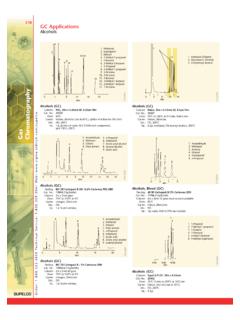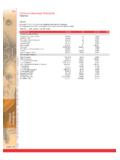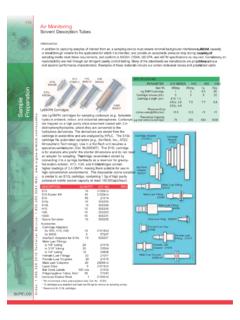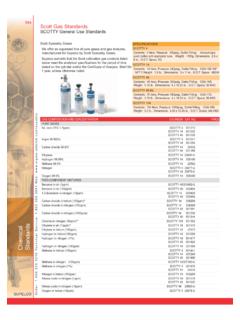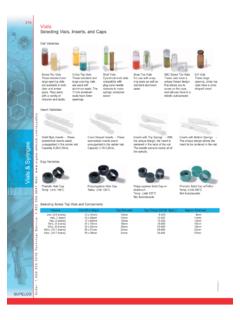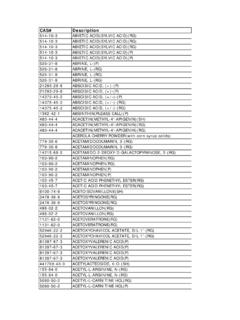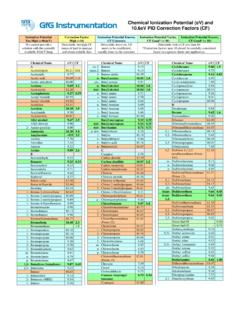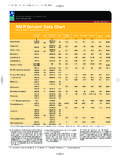Transcription of Chemical Standards - SUPELCO
1 611 ChemicalStandardsSUPELCO611 Order: Technical Service: Web: ReagentsAcylation, an alternative to silylation, is the conversion of compounds that contain active hydrogens (-OH, -SH and -NH) into esters,thioesters, and amides through the action of a carboxylic acid or derivative. The presence of a carbonyl group adjacent to the haloge-nated carbons enhances electron capture detector (ECD) has many benefits: It improves stability of compounds by protecting unstable groups. It may confer volatility on substances such as carbohydrates or amino acids, which have so many polar groupings that they are nonvolatileand normally decompose on heating. It assists in separations not possible with underivatized compounds. Compounds are detectable at very low levels with an Acid Anhydrides Acylation reduces the polarity of amino, hydroxyl, and thiol groups to form perfluoroacyl derivatives,which are both stable and highly volatile. Fluorinated anhydride derivatives are used primarily for ECD, but also can be used for flameionization detection (FID).
2 They react with alcohols, phenols, and amines to produce stable derivatives. Fluorinated anhydrides are usedin derivatizing samples for drug of abuse anhydrides and acyl halide reagents form acid byproducts, which must be removed in GC analysis to prevent destructive effects onthe column. Acylations with anhydride reagents are normally performed in pyridine, tetrahydrofuran, or some other solvent capable ofaccepting the acid byproduct. Amine bases also may be used as catalysts/acid Perfluoroacylimidazoles offer advantages over anhydrides in preparing perfluoroacyl derivatives. Thereactions are smooth and quantitative, and produce no acid byproducts that must be removed from the system before injection. Theactivated amide reagents yield no acid byproducts, giving only imidazole and N-methyltrifluoroacetamide, respectively. Theperfluoroacylimidiazoles react with hydroxyl groups, both primary and secondary amines, and quantitatively acylate into Acylation Reagents N-methylbis(trifluoroacetamide) reacts with amines at room temperature.
3 Hydroxyl derivatizations areslower; heat is for Acylation ReagentsACRONYMCHEMICAL NAMECAS anhydride336-59-4 MBTFAN-Methylbis (trifluoroacetamide)685-27-8 PFPAP entafluoropropionic anhydride356-42-3 TFAAT rifluoroacetic anhydride407-25-0 TFAI1-(Trifluoroacetyl) imidazole1546-79-8 Acylation Anhydride10 x 2mL33085 HFBA10 x 1mL33170-U MBTFA5mL394939-5ML PFPA10 x 1mL33167 25mL33168 TFAA10 x 1mL33165-U 25mL33164 TFAI5mL394920-5ML RELATED INFORMATIONB ulletin 909 contains detailed information on selecting a suitablederivatization reagent for most applications. Request a free copy ofBulletin 909 by phone or fax, or see our reagentsDerivatization ReagentsAcylation Reagents612 ChemicalStandardsSUPELCO612 Order: Technical Service: Web: ReagentsAlkylation involves the addition of an alkyl group (aliphatic or aliphatic-aromatic) to an active functional (H) group.
4 Replacement ofhydrogen with an alkyl group is important because of the decreased polarity of the derivative as compared with the parent reagent is used to modify compounds containing acidic hydrogens such as carboxylic acids and resulting products are ethers, esters, thioethers, thioesters, n-alkyl amines, and n-alkyl amides. Alkylation of weakly acidic groups(alcohols) requires strongly basic catalysts (sodium methoxide, potassium methoxide). More acidic OH groups, as in phenols andcarboxylic acids, require less basic catalysts (hydrogen chloride, boron trifluoride).DMF-Dialkyl acetals Dimethylformamide dialkyl acetals are used to esterify acids to their methyl esters. Hydroxyl groups are notmethylated with this reagent. Carboxylic acids, phenols, and thiols quickly react to give the corresponding alkyl derivatives. N,N-dimethylformamide dimethyl acetals are moisture Diazomethane reacts rapidly with unesterified fatty acids in the presence of a small amount of methanol, which catalysesthe reaction to form methyl esters.
5 The yield is high and the side reactions are minimal. Diazomethane is a yellow gas which usually isused as an ethereal solution, with some methanol present; the elimination of gaseous nitrogen drives the reaction. Diazomethane iscarcinogenic, highly toxic, potentially explosive, and unstable. Diazomethane is not ideal for esterification of phenolic acids because thephenolic hydroxyl groups are also methylated at a slower rate, which may lead to mixtures of partially methylated and Transesterification Reagents Esterification is the reaction of an acid with an alcohol in the presence of a catalystto form an ester. The process involves the condensation of the carboxyl group of the acid and the hydroxyl group of the alcohol, withthe elimination of water. Esterification is best done in the presence of a catalyst ( , hydrogen chloride), which is removed with is the most popular alkylation method. Alkyl esters offer excellent stability, and provide quick and quantitative samplesfor GC is the displacement of the alcohol from an ester by another alcohol.
6 This has been widely used for making esters ofhigher alcohols from those of lower alcohols. Transesterification can be performed with an acidic or basic catalyst using methanol toreact with fats and Alkylation Reagents Pentafluorobenzyl bromide is convenient for making esters and ethers and has been used in traceanalysis. This reagent is a strong lachrymator and should be handled only in a hood. Hexacyclooctadecane andpentafluorobenzylbromide are reagents for preparing pentafluorobenzyl phenol derivatives for US EPA Method 604. Esterate-M is usedin the preparation of methyl and other esters of long chain fatty acids by reaction with dimethylformamide dialkylacetals. Aldehydesand ketones are conveniently derivatized by forming oximes with o-alkylhydroxylamine HCl reagents. O-methylhydroxylamine HCl hasbeen used with ketosteroids, prostaglandins, saccharides, aldoacids, and ketoacids. N-butylboronic acid reacts with 1,2- or 1,3-diols orwith - or -hydroxy acids to form 5- or 6-member ring nonpolar boronate derivatives.
7 They are prepared simply by adding n-butylboronic acid to a solution of the hydroxy compound in for Alkylation ReagentsACRONYMCHEMICAL NAMECAS Diazald-N-methyl-13CN-Methyl-13C-N-nitro so-p-toluenesulfonamide60858-95-9 Diazald-N-methyl-13C-N-methyl-d3N-Methyl -13C-d3-N-nitroso-p-toluenesulfonamide10 2832-11-1 DMF-DBAN,N-Dimethylformamide di-tert-butyl acetal36805-97-7 DMF-DEAN,N-Dimethylformamide diethyl acetal1188-33-6 DMF-DMAN,N-Dimethylformamide dimethyl acetal4637-24-5 DMF-DPAN ,N-Dimethylformamide dipropyl acetal6006-65-1 DMP2,2-Dimethoxypropane77-76-9 Esterate M2meq DMF-DMA in 1mL pyridine MNNG1-Methyl-3-nitro-1-nitrosoguanidine7 0-25-7 NBBn-Butylboronic acid4426-47-5 PFBBrPentafluorobenzyl bromide1765-40-8 TMAHT rimethylanilinium RELATED INFORMATIONB ulletin 909 contains detailed information on selecting a suitablederivatization reagent for most applications. Request a free copy ofBulletin 909 by phone or fax, or see our reagentsDerivatization ReagentsAlkylation Reagents613 ChemicalStandardsSUPELCO613 Order: Technical Service: Web: ReagentsDESCRIPTIONCAT.
8 X 1mL395005-10X1ML 5mL395005-5ML 25mL395005-25ML DMF-DEA (1,1-Diethoxytrimethylamine)10 x 1mL394971-10X1ML 5mL394971-5ML 25mL394971-25ML DMF-DMA10 x 1mL394963-10X1ML 5mL394963-5ML 25mL394963-25ML DMF-DPA10 x 1mL394998-10X1ML 5mL394998-5ML 25mL394998-25ML DiazoalkalesDiazald25gD28000-25G 100gD28000-100G 500gD28000-500G 1kgD28000-1KG MNNG, 97%10g129941-10G 25g129941-25G (Trimethylsilyl)diazomethane ( solution in hexanes)5mL362832-5ML 25mL362832-25ML DESCRIPTIONCAT.
9 Reagents*BCl3-2-Chloroethanol (11% w/w)10 x 1mL33056-U BCl3-Methanol (12% w/w)20 x 1mL33353 20 x 2mL33089-U 400mL33033 BF3-Butanol (10% w/w)10 x 5mL33126-U 100mL33125-U BF3-Methanol (10% w/w)20 x 1mL33356 19 x 2mL33020-U 10 x 5mL33040-U 5mL264121-5ML 250mL264121-250ML 400mL33021 BF3-PrOH (14% w/w)5g156825-5G 100g156825-100G 500g156825-500G Methanolic , 30mL33352 , 100mL33080 Methanolic , 20 x 1mL33354 , 10 x 5mL33095 3N, 20 x 1mL33355 3N, 10 x 3mL33051 3N, 400mL33050-U Methanolic H2SO4 (10% v/v)6 x 5mL506516 TMAH, in methanol10 x 1mL33358-U 10mL33097-U General Alkylation Reagents*DMP (2,2-Dimethoxypropane)25g33053 Esterate M25mL33140 Hexaoxacyclooctadecane (18 crown 6)25g33003-U O-Methoxyamine HCl5g33045-U Pentafluorobenzyl bromide5g33001 *Product specification sheets are available for most of these reagents.
10 Informationincludes properties, features and benefits, typical derivatization procedure,mechanism, toxicity, hazards, and stability. For free literature, request a copy byphone or see our Web ReagentsAlkylation Reagents614 ChemicalStandardsSUPELCO614 Order: Technical Service: Web: , DERIVATIZATION GRADE144 x 20 x 1mL33036 25mL33037-U BSA + TMCS, 5:1 (SYLON BT)20 x 1mL33018 25mL33019-U BSA + TMCS + TMSI, 3:2:3 (SYLON BTZ)144 x 20 x 1mL33030 25mL33031-U BSTFA, DERIVATIZATION GRADE144 x 20 x 1mL33024 25mL33027 BSTFA + TMCS, 99:1 (SYLON BFT)144 x 20 x 1mL33148 25mL33155-U 50mL33149-U HMDS30mL33350-U 100mL33011 HMDS + TMCS, 3:1 (SYLON HT)20 x 1mL33046 REACTA-SIL CONCENTRATE (HMDS:TMCS, 2.)
